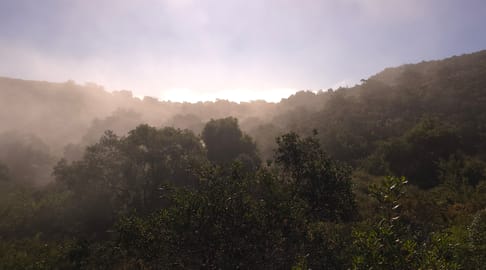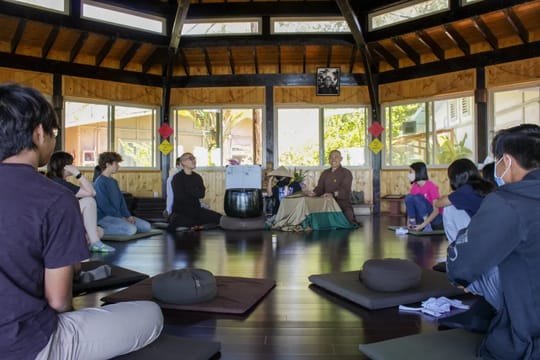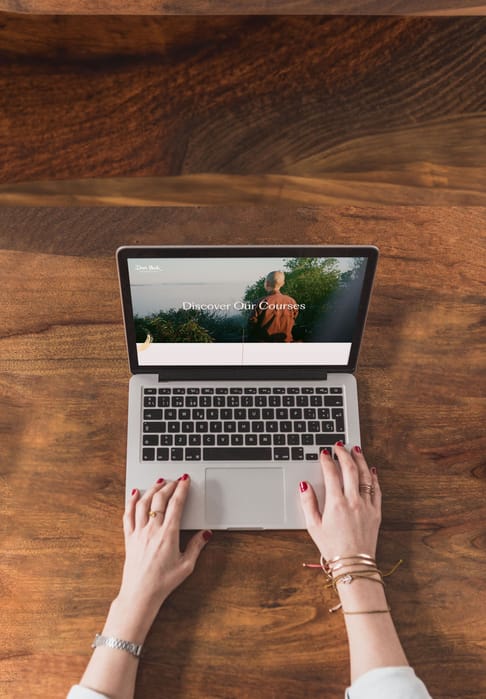Guided Meditation Exercise 04
Boundless Space

Boundless Space


Turn Your Inbox into a Dharma Door
Subscribe to our Coyote Tracks newsletter on Substack to receive event announcements, writing, art, music, and meditations from Deer Park monastics.
Support Deer Park
Donations are our main source of support, so every offering is greatly appreciated. Your contribution helps us to keep the monastery open to receive guests throughout the year.
DonateBreathing in, I know I am breathing in / In
Breathing out, I know I am breathing out / Out
Breathing in, I see myself as a flower / Flower
Breathing out, I feel fresh / Fresh
Breathing in, I see myself as a mountain / Mountain
Breathing out, I feel solid / Solid
Breathing in, I become still water / Still water
Breathing out, I reflect the sky and mountains / Reflecting
Breathing in, I become vast space / Vast space
Breathing out, I feel free and boundless / Free
This exercise can be practiced at the beginning of any sitting meditation session, or it can be practiced throughout an entire session to nourish and calm the body and mind, leading to deep relaxation and freedom.
The first breath can be practiced multiple times until the body and mind are unified, creating a sense of wholeness.
The second breath brings freshness. A human being is meant to be fresh like a flower because we, too, are flowers in the garden of life. We can see this in the beauty of young children—their clear eyes are like blossoms, their bright faces and gentle foreheads are like flowers. Our hands, too, are flowers. But as we worry, our foreheads wrinkle. As we cry and suffer sleepless nights, our eyes grow weary. Breathing in, we restore our flower-like nature. Breathing out, we recognize that we can be and already are fresh like a flower. This is a practice of self-compassion, of watering our inner flower.
The third breath—the mountain—helps us find stability in times of strong emotions. When we are overwhelmed by despair, anxiety, fear, or anger, it can feel as if we are caught in a storm. We may feel like a small tree being shaken by powerful winds. Looking at the branches and leaves, we fear they will break. But if we focus on the trunk, and especially the roots, we see that the tree is firmly planted in the earth.
Our body and mind are the same. When emotions rage like a storm, we can move our awareness from the stormy area—the brain—to the lower belly, just below the navel, and breathe deeply and slowly. As we follow our breath with the mantra Mountain, Solid, we begin to see that we are more than our emotions. Emotions come and go, but we remain.
In moments of deep suffering, some people, especially the young, may feel that the only way to end suffering is to end their life. Many have taken this path. But if they knew how to sit down in lotus position and breathe Mountain, Solid, they might be able to pass through the difficult moment. This practice can also be done lying down, simply observing the gentle rise and fall of the belly with each breath. In doing so, we step out of the storm and allow it to pass without being swept away.
It is important not to wait until suffering arises to practice this breath. If we do not cultivate the habit, we may forget to use it when needed. By practicing daily, we build resilience so that when emotions arise, we naturally turn to this meditation to embrace and transform them. We can also teach this practice to young people, helping them navigate the storms of their emotions.
The fourth breath—still water—helps calm the body and mind. In the Discourse on the Full Awareness of Breathing, the Buddha teaches: “Breathing in, I calm my mind…” This is the same practice, using the image of a still lake to make it more tangible.
When our mind is unsettled, our perception is often distorted. What we see, hear, and think may not reflect reality, just as a body of water with ripples cannot clearly reflect the sky and clouds.
"The Buddha is like the fresh full moon
that soars across the immense sky,
when the river of mind is truly calm
the deep waters perfectly mirror the radiance of the moon."
Our suffering often comes from mistaken perceptions. To avoid this, we must train our mind to be calm and clear, like a still lake on a quiet morning. The breath helps us achieve this.
The fifth breath—boundless space—brings spaciousness into our hearts and minds. When we are caught in busyness and worries, we lose our sense of freedom. This breath invites us to create space, both inside and around us. If we are overwhelmed by projects, ambitions, or burdens, we may need to let some go.
We also need to release the weight of resentment, grief, and attachment. Sometimes we believe that our happiness depends on certain possessions, positions, or relationships. But if we reflect deeply, we may realize that these things are actually obstacles to our happiness. Letting go can bring us true freedom.
"The Buddha is like the fresh full moon
that soars across the immense sky,."
The immense sky represents spaciousness, and this spaciousness is the foundation of the Buddha’s happiness.
One day, as the Buddha was sitting with the monks in the Great Forest near the city of Vaiśālī, a farmer passed by, looking distraught. He asked the Buddha if he had seen his lost cows. He explained that his cows had run away, and his sesame crops had been destroyed by pests. He felt like the most miserable person in the world and said he was considering ending his life.
The Buddha replied, “Perhaps you should look elsewhere.”
After the farmer left, the Buddha smiled at the monks and said, “Dear friends, do you know how fortunate you are? You have no cows to lose.”
Practicing this breath helps us let go of our cows—the burdens in our mind and our external attachments. True freedom comes when we stop clinging.
From time to time we offer multi-week courses related to mindfulness, the teachings and life of Thich Nhat Hanh, and a variety of similar subjects. Please see our schedule of upcoming courses.

Take the Deer Park Monastery and Plum Village community with you wherever you go. The Plum Village app is designed to cultivate mindfulness, compassion, and joy through guided meditations, deep relaxations, practice poems, bells of mindfulness, and other practices — all through a mobile device.
